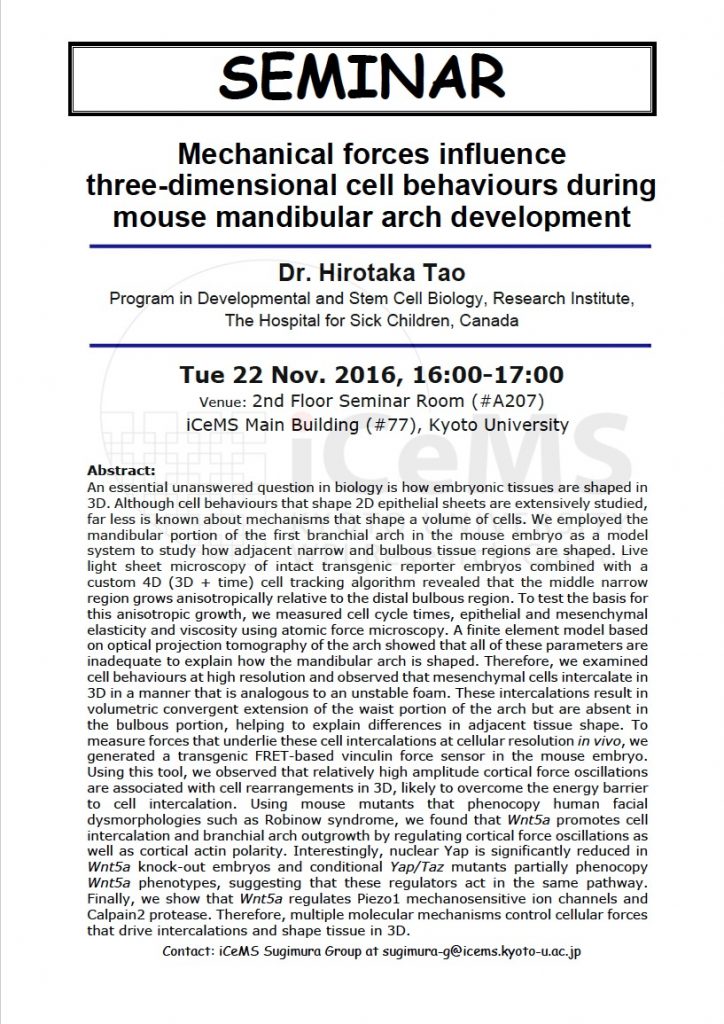iCeMS杉村グループセミナー:Hirotaka Tao 博士

Mechanical forces influence three-dimensional cell behaviours during mouse mandibular arch developme
An essential unanswered question in biology is how embryonic tissues are shaped in 3D. Although cell behaviours that shape 2D epithelial sheets are extensively studied, far less is known about mechanisms that shape a volume of cells. We employed the mandibular portion of the first branchial arch in the mouse embryo as a model system to study how adjacent narrow and bulbous tissue regions are shaped. Live light sheet microscopy of intact transgenic reporter embryos combined with a custom 4D (3D + time) cell tracking algorithm revealed that the middle narrow region grows anisotropically relative to the distal bulbous region. To test the basis for this anisotropic growth, we measured cell cycle times, epithelial and mesenchymal elasticity and viscosity using atomic force microscopy. A finite element model based on optical projection tomography of the arch showed that all of these parameters are inadequate to explain how the mandibular arch is shaped. Therefore, we examined cell behaviours at high resolution and observed that mesenchymal cells intercalate in 3D in a manner that is analogous to an unstable foam. These intercalations result in volumetric convergent extension of the waist portion of the arch but are absent in the bulbous portion, helping to explain differences in adjacent tissue shape. To measure forces that underlie these cell intercalations at cellular resolution in vivo, we generated a transgenic FRET-based vinculin force sensor in the mouse embryo. Using this tool, we observed that relatively high amplitude cortical force oscillations are associated with cell rearrangements in 3D, likely to overcome the energy barrier to cell intercalation. Using mouse mutants that phenocopy human facial dysmorphologies such as Robinow syndrome, we found that Wnt5a promotes cell intercalation and branchial arch outgrowth by regulating cortical force oscillations as well as cortical actin polarity. Interestingly, nuclear Yap is significantly reduced in Wnt5a knock-out embryos and conditional Yap/Taz mutants partially phenocopy Wnt5a phenotypes, suggesting that these regulators act in the same pathway. Finally, we show that Wnt5a regulates Piezo1 mechanosensitive ion channels and Calpain2 protease. Therefore, multiple molecular mechanisms control cellular forces that drive intercalations and shape tissue in 3D.
- 講師
-
Hirotaka Tao 博士
Program in Developmental and Stem Cell Biology, Research Institute, The Hospital for Sick Children, Canada
- 演題
- Mechanical forces influence three-dimensional cell behaviours during mouse mandibular arch developme
- 日時
- 2016年11月22日(火) 16:00-17:00
- 会場
-
京都大学 iCeMS 本館(#77)2階 セミナールーム (A207)
アクセスマップ
- 主催
-
京都大学 物質-細胞統合システム拠点(iCeMS=アイセムス)杉村薫グループ
sugimura-gicems.kyoto-u.ac.jp
-560x340.jpg)






